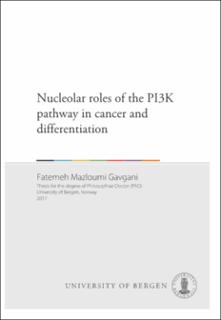Nucleolar roles of the PI3K pathway in cancer and differentiation
Doctoral thesis

Åpne
Permanent lenke
https://hdl.handle.net/11250/3120694Utgivelsesdato
2017-12-18Metadata
Vis full innførselSamlinger
Sammendrag
The phosphoinositide 3-kinase (PI3K) pathway is essential for many cellular functions including; proliferation, cell survival, differentiation and metabolism. Although this pathway has been well studied in the cytoplasm, the role of PI3Ks in the nucleus has also been emerging as essential determinants of cell function. Previous work from our group has mapped the class I PI3K p110β and its product PtdIns(3,4,5)P3 to the nucleus and nucleolus in a breast cancer cell line. Here, we aimed to understand and characterize the role of this kinase and its lipid product in the nucleus during tumorigenesis and adipocyte differentiation. We first found that the PI3K is active in the nucleus of differentiating 3T3-L1 and endometrial cancer cells and identified an active form of Akt in the nucleoli of endometrial cancer cell lines. Using subcellular fractionation, mass spectrometry and different staining methods, we confirmed the nucleolar localization of PtdIns(3,4,5)P3 in several cell types but at different levels. In adipocytes, the levels of p110β were low in the nucleus and nucleoli upon differentiation. In contrast, endometrial cancer cell lines had high amounts of nuclear p110β and PtdIns(3,4,5)P3. The nucleolus is the sub nuclear site where ribosomal RNA (rRNA) transcription and processing occurs and interestingly we found that inhibition of p110β reduced the level of transcription of this RNA species. In addition, endometrial cancer cell lines with high amounts of nuclear p110β and PtdIns(3,4,5)P3 showed significant elevations in pre-rRNA transcription.
To gain further insights of the nuclear roles of PtdIns(3,4,5)P3, we used a quantitative interactomics approach and identified 219 PtdIns(3,4,5)P3 interacting proteins that were highly enriched in cytokinesis, RNA processing and DNA repair functions. PARP1 (Poly (ADP-ribose) polymerase 1), a DNA repair protein abundant in the nucleoli, was one of the identified proteins which was then validated to interact with phosphoinositides directly, including PtdIns(3,4,5)P3. The nucleolar presence and co-localization of PARP1 with PtdIns(3,4,5)P3 was dependent on active rRNA transcription. Altogether the results from this thesis suggests an active role of the class I PI3K p110β and its product PtdIns(3,4,5)P3 in the nucleolus of differentiating adipocytes and endometrial cancer cells but with distinct regulation.
Består av
Paper I: Gavgani FM, Karlsson T, Tangen IL, Morovicz AP, Arnesen VS, Turcu DC, Ninzima S, Spang K, Krakstad C, Guillermet-Guibert J, Lewis AE. Nuclear upregulation of class I phosphoinositide 3-kinase p110β correlates with high 47S rRNA levels in cancer cells. Journal of Cell Science. 2021 Feb 1;134(3):jcs246090. The article is available at: https://hdl.handle.net/11250/2829384Paper II: Gavgani FM, Slinning MS, Morovicz AP, Arnesen VS, Turcu DC, Ninzima S, D’Santos CS, Lewis AE. Nuclear phosphatidylinositol 3, 4, 5-trisphosphate interactome uncovers an enrichment in nucleolar proteins. Molecular & Cellular Proteomics. 2021 Jan 1;20:100102. The article is available at: https://hdl.handle.net/11250/2829276
Paper III: Jacobsen RG, Goris M, Gavgani FM, Ardawatia V, Karlsson T, Lewis AE. Synthesis of phosphatidylinositol 3,4-P2 and phosphatidylinositol 3,4,5-P3 in distinct nuclear sites upon adipocyte differentiation. The article is available in the thesis file.